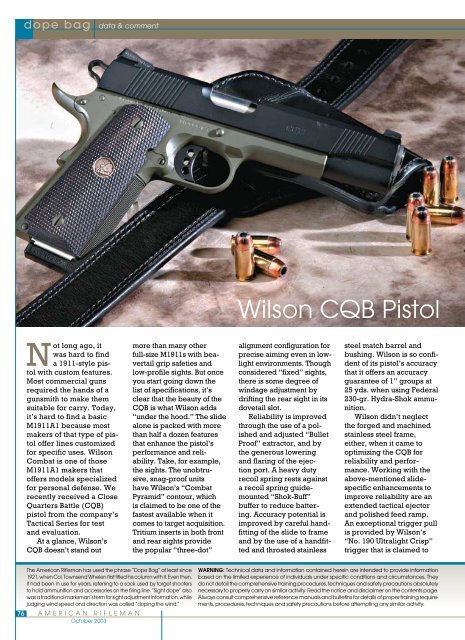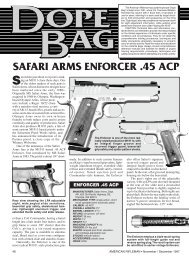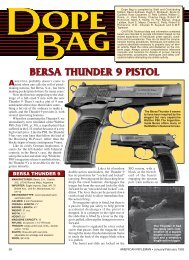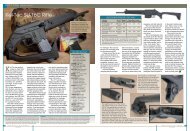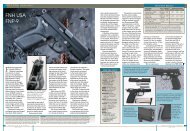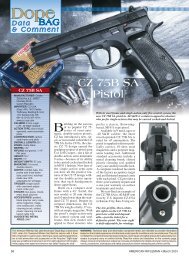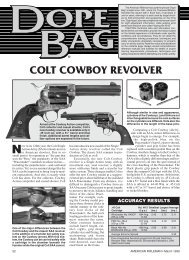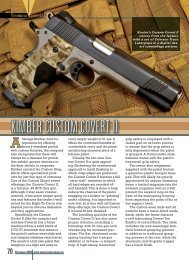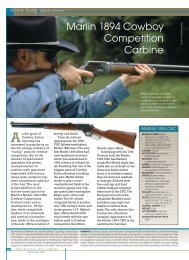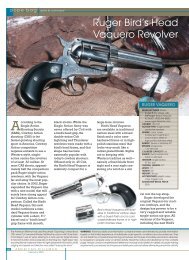Wilson CQB Pistol
Download AR Dope Bag Oct. 2003
Download AR Dope Bag Oct. 2003
- No tags were found...
Create successful ePaper yourself
Turn your PDF publications into a flip-book with our unique Google optimized e-Paper software.
dope bag data & comment<br />
<strong>Wilson</strong> <strong>CQB</strong> <strong>Pistol</strong><br />
Not long ago, it<br />
was hard to find<br />
a 1911-style pistol<br />
with custom features.<br />
Most commercial guns<br />
required the hands of a<br />
gunsmith to make them<br />
suitable for carry. Today,<br />
it’s hard to find a basic<br />
M1911A1 because most<br />
makers of that type of pistol<br />
offer lines customized<br />
for specific uses. <strong>Wilson</strong><br />
Combat is one of those<br />
M1911A1 makers that<br />
offers models specialized<br />
for personal defense. We<br />
recently received a Close<br />
Quarters Battle (<strong>CQB</strong>)<br />
pistol from the company’s<br />
Tactical Series for test<br />
and evaluation.<br />
At a glance, <strong>Wilson</strong>’s<br />
<strong>CQB</strong> doesn’t stand out<br />
more than many other<br />
full-size M1911s with beavertail<br />
grip safeties and<br />
low-profile sights. But once<br />
you start going down the<br />
list of specifications, it’s<br />
clear that the beauty of the<br />
<strong>CQB</strong> is what <strong>Wilson</strong> adds<br />
“under the hood.” The slide<br />
alone is packed with more<br />
than half a dozen features<br />
that enhance the pistol’s<br />
performance and reliability.<br />
Take, for example,<br />
the sights. The unobtrusive,<br />
snag-proof units<br />
have <strong>Wilson</strong>’s “Combat<br />
Pyramid” contour, which<br />
is claimed to be one of the<br />
fastest available when it<br />
comes to target acquisition.<br />
Tritium inserts in both front<br />
and rear sights provide<br />
the popular “three-dot”<br />
alignment configuration for<br />
precise aiming even in lowlight<br />
environments. Though<br />
considered “fixed” sights,<br />
there is some degree of<br />
windage adjustment by<br />
drifting the rear sight in its<br />
dovetail slot.<br />
Reliability is improved<br />
through the use of a polished<br />
and adjusted “Bullet<br />
Proof” extractor, and by<br />
the generous lowering<br />
and flaring of the ejection<br />
port. A heavy duty<br />
recoil spring rests against<br />
a recoil spring guidemounted<br />
“Shok-Buff”<br />
buffer to reduce battering.<br />
Accuracy potential is<br />
improved by careful handfitting<br />
of the slide to frame<br />
and by the use of a handfitted<br />
and throated stainless<br />
steel match barrel and<br />
bushing. <strong>Wilson</strong> is so confident<br />
of its pistol’s accuracy<br />
that it offers an accuracy<br />
guarantee of 1” groups at<br />
25 yds. when using Federal<br />
230-gr. Hydra-Shok ammunition.<br />
<strong>Wilson</strong> didn’t neglect<br />
the forged and machined<br />
stainless steel frame,<br />
either, when it came to<br />
optimizing the <strong>CQB</strong> for<br />
reliability and performance.<br />
Working with the<br />
above-mentioned slidespecific<br />
enhancements to<br />
improve reliability are an<br />
extended tactical ejector<br />
and polished feed ramp.<br />
An exceptional trigger pull<br />
is provided by <strong>Wilson</strong>’s<br />
“No. 190 Ultralight Crisp”<br />
trigger that is claimed to<br />
The American Rifleman has used the phrase “Dope Bag” at least since<br />
1921, when Col. Townsend Whelen first titled his column with it. Even then,<br />
it had been in use for years, referring to a sack used by target shooters<br />
to hold ammunition and accessories on the firing line. “Sight dope” also<br />
was a traditional marksman’s term for sight adjustment information, while<br />
judging wind speed and direction was called “doping the wind.”<br />
76 AMERICAN RIFLEMAN<br />
October 2003<br />
WARNING: Technical data and information contained herein are intended to provide information<br />
based on the limited experience of individuals under specific conditions and circumstances. They<br />
do not detail the comprehensive training procedures, techniques and safety precautions absolutely<br />
necessary to properly carry on similar activity. Read the notice and disclaimer on the contents page.<br />
Always consult comprehensive reference manuals and bulletins for details of proper training requirements,<br />
procedures, techniques and safety precautions before attempting any similar activity.
WILSON <strong>CQB</strong><br />
MANUFACTURER: <strong>Wilson</strong><br />
Combat (Dept. AR),<br />
2234 CR 719,<br />
Berryville, AR 72616;<br />
(800) 955-4856; www.<br />
wilsoncombat.com<br />
CALIBER: .45 ACP<br />
ACTION TYPE: short-recoil,<br />
center-fire, singleaction,<br />
semi-automatic<br />
FRAME: stainless steel,<br />
OD Green Armor-Tuff<br />
finish<br />
BARREL: 5”, stainless steel<br />
RIFLING: four-groove,<br />
1:16” RH twist<br />
MAGAZINE: detachable<br />
box; single-column,<br />
eight-round capacity<br />
SIGHTS: “Combat<br />
Pyramid” three-dot<br />
sighting system<br />
TRIGGER: single-action;<br />
3 lbs., 9 ozs. pull<br />
OVERALL LENGTH: 8 5 ⁄8”<br />
WIDTH: 1 5 ⁄16”<br />
HEIGHT: 5 3 ⁄4”<br />
WEIGHT: 38 oz.<br />
ACCESSORIES: spare<br />
magazine, pistol rug<br />
SUGGESTED RETAIL PRICE:<br />
$1,895<br />
be set to 3 1 /2 lbs. pull at the<br />
factory. Indeed, we measured<br />
the trigger pull at 3<br />
lbs., 9 ozs.<br />
Other frame features<br />
include a skeletonized<br />
“Ultralight” hammer and<br />
a fully machined sear. The<br />
high-ride beavertail safety<br />
has a raised palm pad to<br />
ensure it’s fully depressed<br />
when the pistol is grasped,<br />
and an extended thumb<br />
safety lever stays securely<br />
in the “safe” position, but<br />
is released without any<br />
dragging or binding.<br />
Aiding handling is a flat<br />
mainspring housing checkered<br />
at 30 lines per inch—<br />
a checkering rate duplicated<br />
on the frontstrap to<br />
provide a positive grasping<br />
surface. The magazine<br />
well is beveled, which<br />
makes magazine speed<br />
changes easier, and the<br />
two eight-round magazines<br />
provided with the <strong>CQB</strong><br />
have bumpers on their<br />
floorplates. For those who<br />
choose to carry an M1911-<br />
style pistol, the <strong>CQB</strong> is<br />
thoroughly dehorned.<br />
Cosmetically, the <strong>CQB</strong><br />
takes the popular two-tone<br />
theme to a new level. The<br />
entire pistol is coated with<br />
corrosion-resistant Armor-<br />
Tuff finish—an attractive<br />
SHOOTING RESULTS<br />
.45 ACP Vel. @ 15’ Energy Group Size In Inches<br />
Cartridge (f.p.s.) (ft.-lbs.) Smallest Largest Average<br />
Federal H-S No. P45HS1 893 Avg. 407 0.94 1.60 1.28<br />
230-gr. JHP<br />
5 Sd<br />
Hornady XTP No. 9112 889 Avg. 351 1.14 2.01 1.64<br />
200-gr. JHP<br />
12 Sd<br />
Remington G-S 1042 Avg. 446 0.44 1.95 1.44<br />
No. GS45APA 185-gr. JHP 23 Sd<br />
Average Extreme Spread: 1.45<br />
Measured average velocity for 10 rounds from a 5” barrel.<br />
Range temperature: 81° F. Humidity: 50%. Accuracy for five<br />
consecutive, five-shot groups at 25 yds. from a Ransom Rest.<br />
Abbreviations: H-S (Hydra-Shok), G-S (Golden Saber), JHP<br />
(jacketed hollow-point), Sd (standard deviation), XTP<br />
(Extreme Terminal Performance).<br />
OD green on the frame and<br />
black on the slide. The finish<br />
is neither a high gloss<br />
nor a dull matte, but rather<br />
a subdued gloss. The color<br />
combination smartly sets<br />
off the unique color of the<br />
black Diamondwood grip<br />
panels.<br />
Our test <strong>CQB</strong> pistol<br />
was function-fired with<br />
several brands of .45 ACP<br />
ammunition for accuracy<br />
in a Ransom Rest and offhand.<br />
The <strong>CQB</strong> exhibited<br />
an odd tendency toward<br />
weak ejection when fired<br />
in the Ransom Rest, resulting<br />
once in a jam, but<br />
functioned flawlessly when<br />
fired offhand. Accuracy<br />
was, as to be expected,<br />
well above average and<br />
resulted in some very tight<br />
groups as can be seen in<br />
the accompanying table.<br />
The <strong>Wilson</strong> <strong>CQB</strong> most<br />
definitely lives up to the<br />
reputation of the <strong>Wilson</strong><br />
name. It offers the buyer<br />
an extremely high-quality<br />
pistol with impeccable<br />
handling and shooting characteristics—all<br />
in a package<br />
supremely suited for its<br />
intended role.<br />
The <strong>CQB</strong>’s polished feed ramp (arrow) is one of<br />
many touches that adds to the pistol’s reliability<br />
and is another sign of <strong>Wilson</strong>’s attention to detail.<br />
Accuracy potential is improved<br />
by the use of a handfitted and<br />
throated stainless steel match<br />
barrel and bushing.<br />
Thirty-line-per-inch checkering on the<br />
frontstrap provides a positive grasping<br />
surface, enhancing the <strong>CQB</strong>’s<br />
handling. The same checkering is<br />
used on the flat mainspring housing.<br />
The <strong>CQB</strong> comes standard with a<br />
“Shok-Buff” buffer to reduce battering<br />
and perceived recoil.<br />
A skeletonized “Ultralight” hammer<br />
combines with a high-ride beavertail<br />
safety for improved shooting<br />
and handling characteristics.<br />
AMERICAN RIFLEMAN<br />
October 2003<br />
77
78<br />
dope bag data & comment<br />
Silma 70EJ Deluxe 20 Ga.<br />
A<br />
few decades ago,<br />
well before the time<br />
of many current<br />
American Rifleman readers,<br />
some pundit stated that<br />
“what this country needs<br />
is a good five-cent cigar.”<br />
To that, one might also add<br />
99-cent-a-gallon gasoline, a<br />
AMERICAN RIFLEMAN<br />
October 2003<br />
$10 dress shirt, truly affordable<br />
health care and a<br />
reasonably priced, quality<br />
over-under shotgun.<br />
With the stackbarrel<br />
offerings of the major gunmakers<br />
starting at a fourfigure<br />
level, it has been left<br />
to some smaller but no less<br />
reputable firms to fill the<br />
economy niche, with guns<br />
that often compare well on<br />
a feature-by-feature basis<br />
with their more expensive<br />
competitors. One of these<br />
firms is Silma, a 50-yearold<br />
family-owned business<br />
in Brescia, Italy, that<br />
SILMA 70EJ DELUXE<br />
MANUFACTURER: Silma<br />
s.r.l., Via l Maggio,<br />
74, 25060 Zanano<br />
di Sarezzo (BS) Italy;<br />
www.silma.net<br />
IMPORTER: Legacy Sports<br />
Int’l (Dept. AR),<br />
206 S. Union St.,<br />
Alexandria, VA 22314,<br />
(703) 548-4837, www.<br />
legacysports.com<br />
GAUGE: 12, 20 (tested),<br />
28, .410 bore<br />
ACTION TYPE: over-under,<br />
boxlock shotgun<br />
RECEIVER: nickel steel,<br />
nickel-plated<br />
BARREL: chrome-moly<br />
steel, 27 7 ⁄16”<br />
CHOKES: interchangeable<br />
choke tubes<br />
TRIGGER: single nonselective,<br />
6 lbs., 8 ozs.<br />
pull (lower), 6 lbs.,<br />
12 ozs. pull (upper)<br />
STOCK: European walnut:<br />
length of pull, 14 3 ⁄8”;<br />
drop at heel, 2 1 ⁄4”; drop<br />
at comb, 1 5 ⁄16”<br />
OVERALL LENGTH: 44 7 ⁄8”<br />
WEIGHT: 6 lbs., 10 ozs.<br />
ACCESSORIES: improved<br />
cylinder, modified, full<br />
choke tubes; choke<br />
tube wrench<br />
SUGGESTED RETAIL PRICE:<br />
$823<br />
produces shotguns and<br />
double rifles. Currently<br />
imported by Legacy Sports<br />
Int’l of Alexandria, Va., are<br />
three over-under shotgun<br />
models: the 70EJ Standard,<br />
70EJ Lightweight and 70EJ<br />
Deluxe reviewed here.<br />
The Silma Model 70EJ<br />
Deluxe we received for testing<br />
typifies the Silma line,<br />
characterized by traditional<br />
design and construction. Its<br />
chrome-molybdenum steel<br />
barrels are assembled in<br />
the monobloc style, with a<br />
solid rib joining the upper<br />
and lower tubes. A 1/4”-<br />
wide ventilated rib, crosshatched<br />
to reduce light<br />
reflection, is set atop the<br />
upper barrel, and sports<br />
a 0.11”-diameter goldcolored<br />
front bead. Both<br />
barrels, in all gauges, are<br />
threaded for choke tubes;<br />
our sample came with a<br />
full tube in the upper barrel<br />
and a modified tube in<br />
the lower. All 70EJ variants<br />
come with three tubes—<br />
improved cylinder, modi-
The Silma Model 70EJ Deluxe is an economical yet robust choice for those<br />
who favor over-under 20-ga. shotguns.<br />
The barrels employ the<br />
monobloc principle. A<br />
tapered notch (arrow)<br />
is engaged by locking bolt.<br />
The barrels accept choke<br />
tubes. Our sample came<br />
with a full in the upper barrel<br />
and a modified in the lower.<br />
Simple and rugged,<br />
the Silma’s lockwork<br />
(l.) features a nonselective<br />
mechanical<br />
trigger and an<br />
automatic triggerblocking<br />
safety.<br />
AVERAGE OF 10 PATTERNS AT 40 YDS.<br />
23 20 20 21<br />
30 28 40 40<br />
29 30 37 38<br />
21 20 18 19<br />
MODIFIED<br />
FULL<br />
CHOKE<br />
CHOKE<br />
=Point of Hold<br />
Winchester Super-X Field Load<br />
20 Ga., 2 3 ⁄4”—1 oz.—No. 7 1 ⁄2 lead<br />
Average Pellet Count: 324<br />
Measured Velocity @ 3 ft.: 1221 f.p.s.<br />
fied and full—and cylinder<br />
and improved-modified<br />
tubes are also available.<br />
Both the 70EJ Standard<br />
and Deluxe can be had in<br />
12, 20 and 28 gauge, as well<br />
as .410 bore. Chambers<br />
are 3 1 /2” on 12-ga. barrels,<br />
3” on 20-ga. and .410-<br />
bore barrels, and 2 3 /4” on<br />
28-ga. barrels. The 70EJ<br />
Lightweight, which features<br />
an aluminum alloy receiver,<br />
is offered in 12- and<br />
20-ga. versions only. The<br />
70EJ Standard and Deluxe<br />
are mechanically identical;<br />
the latter distinguished by<br />
its wood and engraving.<br />
Two receiver sizes are<br />
used on the 70EJ shotguns:<br />
one for 12-ga. models and<br />
another, trimmer, unit for<br />
the smaller bore sizes.<br />
The blued barrels of<br />
the 70EJ Deluxe are set off<br />
by the gun’s nickel-plated<br />
boxlock receiver, which is<br />
extensively roll-engraved<br />
with game scenes and scroll<br />
ornamentation. The walnut<br />
pistol-grip buttstock and<br />
schnabel fore-end feature<br />
18-line-per-inch, machinecut<br />
checkered panels and<br />
a 3/8”-thick black rubber<br />
recoil pad. Fore-end attachment<br />
to the lower barrel is<br />
through a recessed underlever.<br />
Both the trigger guard<br />
and top lever of the 70EJ<br />
Deluxe are blued, while the<br />
trigger is gold-plated.<br />
Mechanically, the 70EJ<br />
Deluxe features a single,<br />
non-selective trigger (that<br />
always fires the bottom<br />
barrel first) and a triggerblocking<br />
sliding tang safety<br />
that automatically engages<br />
whenever the action is<br />
opened. Hammer cocking<br />
is by way of a single,<br />
robust bar in the bottom of<br />
the receiver that is pushed<br />
rearward by a finger on<br />
the fore-end iron when the<br />
action is opened.<br />
Lockup is accomplished<br />
via a single locking bolt<br />
that enters a recess in the<br />
monobloc. Both the locking<br />
recess and locking<br />
bolt are tapered to ensure<br />
tight lockup even after<br />
wear occurs. Overall, the<br />
Silma’s lockwork appeared<br />
robust and capable of giving<br />
long service. The gun<br />
also has automatic ejectors<br />
(hence the “EJ” model<br />
designation)—a welcome<br />
feature when quick shooting<br />
in the field is required.<br />
Our 70EJ Deluxe balanced<br />
at a point about 3/4”<br />
forward of the hinge pins,<br />
and that, coupled with its<br />
6-lb., 10-oz. weight gave it<br />
a lively feel in the field. The<br />
stock fit our test-firer—an<br />
average-sized man—quite<br />
well, with its comb height<br />
and roughly 1/4” of cast-off<br />
naturally placing his eye<br />
in near-perfect alignment<br />
with the rib and bead.<br />
Additionally, the shape and<br />
size of the pistol grip and<br />
fore-end both contributed<br />
to the gun’s comfortable,<br />
natural feel. Firing at both<br />
machine- and hand-thrown<br />
clay birds proved the gun<br />
capable of satisfying performance.<br />
With a Winchester<br />
Super-X field load of 1 oz.<br />
of No. 7 1 ⁄2 lead shot, both<br />
barrels with their respective<br />
choke tubes patterned<br />
SHOOTING RESULTS<br />
Total Hits 201 (62%) Total Hits 233 (72%)<br />
21” Inner Circle 117 (36%) 21” Inner Circle 155 (48%)<br />
30” Outer Ring 84 (26%) 30” Outer Ring 78 (24%)<br />
within the standard percentages<br />
for those chokes.<br />
The patterns were slightly<br />
high in relation to the point<br />
of hold. There were no malfunctions<br />
during clay target<br />
shooting or patterning.<br />
With its two-tone appearance,<br />
deep-blue barrels,<br />
well-executed roll engraving,<br />
and well-shaped (if<br />
plain) hardwood stocks we<br />
considered our Silma Model<br />
70EJ Deluxe to be visually<br />
appealing for a field-grade<br />
gun. Nonetheless, there<br />
were some areas for cosmetic<br />
improvement. For<br />
example, the gun’s machine<br />
checkering was even but<br />
not sufficiently deep to produce<br />
sharp diamonds. Also,<br />
there were a few very minor<br />
blemishes on the finish of<br />
the nickeled receiver.<br />
The Silma 70EJ Deluxe is<br />
an attractive, fast-swinging<br />
and low-recoiling gun that<br />
is also mechanically robust.<br />
At a list price of $823, it<br />
represents an excellent<br />
value for the cost-conscious<br />
20-ga. shotgunner.<br />
AMERICAN RIFLEMAN<br />
October 2003<br />
79
dope bag data & comment<br />
80<br />
Heckler & Koch P2000 US<br />
Based on the successful<br />
USP Compact<br />
(February 1997,<br />
p. 36), the new P2000 US<br />
offers a limited choice of<br />
trigger options and several<br />
features new to H&K<br />
that were developed for<br />
European police agencies.<br />
While only one fire control<br />
system is offered, it is of<br />
significant interest.<br />
The P2000 at present<br />
comes in 9 mm Luger and<br />
.40 S&W with no decocker<br />
or manual safety. It is<br />
essentially a “slick-slide”<br />
semi-automatic, as its only<br />
external control lever is<br />
the ambidextrous slide<br />
release. The heart of the<br />
pistol is what H&K call its<br />
“LEM” trigger (for Law<br />
Enforcement Modification),<br />
which is essentially a<br />
double-action-only trigger<br />
in terms of its length<br />
of pull, but with a singleaction<br />
pull weight. When<br />
the slide is retracted, the<br />
hammer travels rearward,<br />
compresses the hammer<br />
spring and, on LEMequipped<br />
guns, an audible<br />
AMERICAN RIFLEMAN<br />
October 2003<br />
click is heard. As the slide<br />
travels forward again, so<br />
do the hammer and trigger,<br />
which are linked by<br />
the trigger bar. But the<br />
majority of the tension has<br />
been taken off the hammer<br />
spring (much like a<br />
set trigger), so it is “precocked,”<br />
requiring a lesser<br />
amount of pressure, but<br />
the same length of travel,<br />
to cock the hammer and<br />
release the sear for firing.<br />
Unlike many “precocked”<br />
semi-automatic<br />
designs, the P2000 still<br />
employs a spurless<br />
hammer, so it still has a<br />
“second-strike” capability<br />
in the event of a misfire.<br />
The trigger may be pulled<br />
again, but at the full<br />
double-action pull weight,<br />
and length, because the<br />
gun’s hammer spring is not<br />
pre-cocked.<br />
The frame has a slightly<br />
different look and feel than<br />
the USP Compact, while<br />
remaining dimensionally<br />
very similar. On the sides<br />
of the polymer frame there<br />
are vertical ridges and the<br />
“HK2000” logo as opposed<br />
to the stippling pattern of<br />
the USP Compact. There<br />
are shallow finger grooves<br />
on both sides of the frame<br />
that make the P2000<br />
seem thinner in the hand,<br />
though the depth is only<br />
0.11” greater.<br />
The molded-in accessory<br />
rail on the bottom of<br />
the dustcover has conventional<br />
open side rails as<br />
well as a single under rail<br />
for attachment of a laser,<br />
flashlight or other device.<br />
Previously, H&K had used<br />
a proprietary closed rail<br />
design. The slide’s front<br />
is slightly different from<br />
standard USPs as well, as<br />
its front face is scalloped<br />
more deeply to make holster<br />
insertion easier.<br />
Like the Walther P99<br />
and S&W 99, the P2000<br />
has grip inserts that<br />
allow users to tailor the<br />
backstrap shape to their<br />
individual preferences.<br />
The gun comes with three<br />
inserts, marked “S,” “M”<br />
or “L” for small, medium<br />
or large. Changing them<br />
out is easily accomplished<br />
by driving out the roll pin<br />
at the backstrap’s bottom<br />
rear, sliding the existing<br />
backstrap off, inserting<br />
the new one and replacing<br />
the pin. Trigger reach<br />
as well as backstrap<br />
shape are affected by the<br />
change.<br />
Otherwise, the standard<br />
USP Compact design is<br />
employed. The frame is<br />
fiber-reinforced molded<br />
polymer, and there are<br />
steel inserts molded in<br />
on each side of the frame<br />
rails where the slide bears<br />
against the frame. The<br />
front pair are just forward<br />
of the slide stop and are<br />
0.515” long while the rear<br />
pair behind the ejector are<br />
0.282” in length. The 3 9 /16”-<br />
long barrel is cold-hammerforged,<br />
has polygonal<br />
rifling and locks-up in modified<br />
Browning fashion. Like<br />
the Compact, the P2000<br />
employs a dual captive<br />
recoil spring assembly with<br />
a buffer at its front.<br />
On the bottom of the<br />
trigger guard just forward
H&K P2000 US<br />
MANUFACTURER: Heckler<br />
& Koch GmbH, Box<br />
239, Neckar, Germany<br />
IMPORTER: Heckler &<br />
Koch, Inc., (Dept. AR),<br />
21480 Pacific Blvd.,<br />
Sterling, VA 20166;<br />
(703) 450-1900; www.<br />
hecklerkoch-usa.com<br />
CALIBER: 9x19 mm,<br />
.40 S&W (tested)<br />
ACTION TYPE: short recoil,<br />
double-action-only,<br />
semi-automatic pistol<br />
FRAME: fiber-reinforced<br />
molded polymer<br />
BARREL: 3 9 ⁄16”<br />
RIFLING: polygonal,<br />
1:10” RH twist<br />
MAGAZINE: detachable<br />
box; double-column,<br />
10-round capacity<br />
SIGHTS: three-dot tritium;<br />
ramp front drift adjustable<br />
for windage and<br />
elevation<br />
TRIGGER: double-action:<br />
“LEM” 6 lbs., 8 ozs. pull;<br />
double-action,<br />
15 lbs. pull<br />
OVERALL LENGTH: 6 7 ⁄8”<br />
WIDTH: 1 3 ⁄8”<br />
HEIGHT: 5 3 ⁄8”<br />
WEIGHT: 38 ozs.<br />
ACCESSORIES: extra<br />
magazine, plastic<br />
case<br />
SUGGESTED RETAIL PRICE:<br />
$890 (with magazine<br />
disconnect safety);<br />
$865 (without)<br />
of the grip frame, the<br />
ambidextrous magazine<br />
release is pressed down<br />
to free the double-column<br />
box magazine.<br />
The large hook extractor<br />
is on the ejection<br />
The P2000 uses a captive recoil spring<br />
assembly. The 3 9 ⁄16” barrel is cold-hammerforged<br />
with polygonal rifling.<br />
Steel inserts (arrows) are molded in on<br />
each side of the fiber-reinforced polymer<br />
frame for slide-bearing surfaces.<br />
port’s right rear. Its top is<br />
marked with red paint visible<br />
when the extractor is<br />
snapped over a cartridge’s<br />
rim, acting as a loaded<br />
chamber indicator. The<br />
ejector is held in place—<br />
like all the fire-control<br />
parts—by the hammer pin<br />
and is a fixed steel unit on<br />
the frame’s left. The pistol<br />
is offered with or without<br />
a magazine disconnect<br />
safety.<br />
H&K’s integral Lock-Out<br />
safety device and a twopronged<br />
key are standard.<br />
The Lock-Out assembly<br />
replaces the lanyard loop<br />
insert, and, when engaged,<br />
blocks the movement of<br />
the gun’s hammer strut and<br />
hammer.<br />
Sights are of the threedot<br />
pattern and contain<br />
tritium. The dots ride in<br />
a steel front ramp and a<br />
low-contour rear sight<br />
base that are both dovetailed<br />
into the slide and,<br />
hence, adjustable for<br />
windage. Elevation is<br />
changed by replacing the<br />
height of the front sight, if<br />
needed.<br />
To fieldstrip the P2000<br />
US, depress the magazine<br />
release and remove the<br />
magazine. Pull the slide<br />
back and inspect the chamber<br />
to ensure the gun is<br />
.40 S&W Vel. @ 15’ Energy Group Size In Inches<br />
Cartridge (f.p.s.) (ft.-lbs.) Smallest Largest Average<br />
Winchester X40SWSTHP 1169 Avg. 471 2.42 3.74 3.43<br />
155-gr. STHP<br />
11 Sd<br />
Remington GS40SWA 1043 Avg. 399 2.42 3.42 2.89<br />
165-gr. GS<br />
12 Sd<br />
Mag-Tech 40B 944 Avg. 356 2.76 3.23 3.01<br />
180-gr. FMC<br />
14 Sd<br />
Average Extreme Spread 3.11<br />
Measured average velocity for 10 rounds from a 3 9 ⁄16” barrel.<br />
Range temperature: 81°F. Humidity: 50%. Accuracy for<br />
five consecutive, five-shot groups at 25 yds. from a sandbag.<br />
Abbreviations: STHP (Silvertip hollow-point), GS (Golden Saber),<br />
FMC (full-metal case), Sd (standard deviation).<br />
unloaded. Retract the slide<br />
about 1/2” to line up the<br />
clearance notch with the<br />
slide stop then push out<br />
the stop from right to left.<br />
Remove the slide, forward,<br />
off the frame. Press rearward<br />
on the dual captive<br />
recoil spring assembly to<br />
remove it. The barrel may<br />
then be lifted out.<br />
The sample P2000 US<br />
in .40 S&W was fired for<br />
accuracy at 25 yds. from<br />
sandbags, and the results<br />
are shown in the accompanying<br />
table. We also<br />
functioned-fired the pistol<br />
and tried various defensive<br />
drills and found that,<br />
though the trigger travel<br />
is long, double taps were<br />
easy to accomplish with<br />
practice. There were no<br />
The slide’s front face is scalloped (top) to ease<br />
holster insertion. Each gun comes with three<br />
backstrap inserts that can be changed out by<br />
driving out the roll pin at the bottom rear.<br />
SHOOTING RESULTS<br />
malfunctions of any kind<br />
during the 400-round test<br />
session, even when mixing<br />
different bullet weights<br />
and styles in the same<br />
magazine.<br />
Several of those familiar<br />
with the USP Compact,<br />
with medium to large<br />
hands, stated the P2000<br />
pointed a little better,<br />
likely due to the finger<br />
groove and grip panel<br />
shape. Also, as the P2000<br />
lacks a frame-mounted<br />
control lever, some shooters<br />
were able to obtain<br />
a higher grip on the gun<br />
than on standard USPs.<br />
The scallop at the front<br />
was credited with making<br />
drawing and re-holstering<br />
a little smoother. One<br />
shooter with smaller<br />
hands preferred the USP<br />
Compact to the medium<br />
or large back-panelequipped<br />
P2000; but, to<br />
be fair, at the time of writing<br />
a sample of the “S”<br />
panel was not available.<br />
With its innovative LEM<br />
trigger system—offering<br />
the piece of mind of a<br />
double-action pull length<br />
and a single-action-like<br />
pull weight—and its grip<br />
panel inserts, the P2000<br />
is one of the simplest and<br />
most user-friendly semiautomatic<br />
pistol designs<br />
we’ve seen in some time.<br />
It adds not a lot of choices,<br />
but lots of versatility<br />
to the USP line.<br />
AMERICAN RIFLEMAN<br />
October 2003<br />
81
82<br />
dope bag data & comment<br />
The technology<br />
of<br />
electronic<br />
hearing protection<br />
continues<br />
to evolve and<br />
improve rapidly.<br />
The first<br />
generation of<br />
electronic hearing<br />
protectors<br />
worked by simply<br />
cutting off<br />
sounds above<br />
approximately<br />
72 decibels<br />
(dB). The resultant<br />
“clipping”<br />
made speech and range<br />
commands hard to understand,<br />
as some words were<br />
cut-off or missed entirely.<br />
Second-generation protectors<br />
offered “dynamic<br />
sound compression” that<br />
compressed peaks of<br />
sound below 70 dB without<br />
cutting them off. That made<br />
range commands easier to<br />
understand, but did little<br />
for low-volume ambient<br />
sound levels.<br />
Enter Advanced Hearing<br />
Products, Inc., with its<br />
third-generation electronic<br />
circuitry. Not only do AHP<br />
ear protectors have sound<br />
compression technology<br />
with super fast attack times<br />
(approximately 2 milliseconds),<br />
they also amplify<br />
AMERICAN RIFLEMAN<br />
October 2003<br />
AHP Electronic<br />
Hearing<br />
Protectors<br />
Electronically, both AHP muff units function completely<br />
independently for natural stereo sound;<br />
there is no connecting wire between them. The two<br />
LR1-N 1.5 volt batteries in each unit provide approximately<br />
200 hours of use at full volume.<br />
low-volume ambient sounds<br />
so that ordinary speech and<br />
range commands are crystal<br />
clear and in natural stereo.<br />
AHP in this manner has<br />
addressed a key shortcoming<br />
of most muff-type hearing<br />
protectors—reduced<br />
situational awareness due<br />
to poor low-level sound<br />
amplification in areas such<br />
as shooting ranges. AHP<br />
offers two models. The<br />
Premier is designed with a<br />
noise reduction ratio (NRR)<br />
of about 26 dB for indoor<br />
shooting ranges where maximum<br />
sound attenuation is<br />
needed in a confined area.<br />
The Slimline is designed<br />
with a NRR of about 21 dB<br />
for use on outdoor ranges<br />
where sound confinement is<br />
not a problem.<br />
The Premier<br />
electronic hearing<br />
protectors we tested<br />
weigh just 15 ozs.<br />
with batteries. The<br />
1 1 /2” deep ear cups<br />
are molded of hard,<br />
black plastic with soft<br />
gray foam inside covering<br />
the electronic<br />
package and batteries.<br />
Soft, 1” thick<br />
seals inside the cups<br />
contact the shooter’s<br />
head and are flexible<br />
enough to seal<br />
around the frames of<br />
shooting glasses. To<br />
stabilize the units comfortably<br />
on the shooter’s head,<br />
a soft, six-part cushion pad<br />
on a 3” diameter black<br />
leather crown spreads the<br />
weight over a large area.<br />
The spring steel frame<br />
holds both ear cups firmly<br />
with a single hinge pin at<br />
their mid- point. Each ear<br />
cup has about 3/4” of individual<br />
height adjustment<br />
with a large, plastic set<br />
knob to secure it in place.<br />
We wore the Premier<br />
unit for long periods both<br />
indoors in coolish temperatures<br />
and outdoors in<br />
high-humidity conditions.<br />
All testers felt they were<br />
exceptionally comfortable<br />
and extremely suitable for<br />
long-term wear.<br />
Electronically, both<br />
AHP cups function completely<br />
independently for<br />
natural stereo sound. That<br />
enables users to adjust<br />
the volume of each unit<br />
to the hearing requirements<br />
of each ear. The<br />
outer surface of each ear<br />
cup has a microphone and<br />
an on-off/volume adjustment<br />
knob. There are no<br />
other controls. The result<br />
is clear sound that seems<br />
perfectly natural. Indeed,<br />
the sound is so natural that<br />
often during our tests we<br />
nearly forgot the protectors<br />
were in use. Sound peaks<br />
are compressed below the<br />
70 dB damage level, but<br />
not clipped. Users felt the<br />
amplification of low-level<br />
ambient sounds made a<br />
world of difference and<br />
did, indeed, increase<br />
situational awareness.<br />
AHP advises that fresh<br />
batteries will provide<br />
approximately 200 hours<br />
of use at full volume due to<br />
the very low power consumption<br />
of about 4 milliamps.<br />
However, when not<br />
in use, the units should be<br />
switched off and the batteries<br />
removed if long-term<br />
storage is planned.<br />
Both units are completely<br />
modular, allowing damaged<br />
parts to be easily replaced<br />
or cleaned. Optional input<br />
jacks allow connection to<br />
radio nets, cellular phones<br />
and other electronic devices<br />
if desired.<br />
In its Premier series of<br />
third-generation electronic<br />
hearing protectors, AHP<br />
has established a new<br />
benchmark in performance<br />
by dramatically improving<br />
sound quality and comfort<br />
for increased situational<br />
awareness and safety.<br />
Available from:<br />
Advanced Hearing<br />
Protection, Inc. (Dept. AR),<br />
6000 Willow Creek Road,<br />
Suite 200, Prescott, AZ<br />
86301; (928) 445-5491


